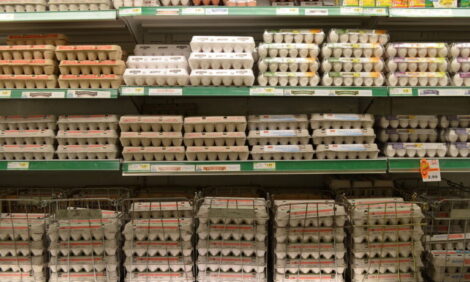



Broiler Production Systems: The ideal stocking density?
By Brian D. Fairchild, Extension Poultry Scientist, University of Georgia - The ideal density at which to place broilers during grow-out is an ongoing debate. There is no definitive answer to this question. It is natural to assume that birds will perform better when given more space. However, it’s not more space but the improved environment that the added space may provide that is important.
The modern broiler house enables producers to have great control over the house environment.
Birds can be placed at higher densities
as long as the correct environment (temperature,
ventilation, humidity) is provided. Factors to consider
when determining stocking density include but are not
limited to bird size, feeder space, drinker space, house
dimensions, bird welfare, nutrition, breed, performance and
economic return.
The ultimate goal is to maximize pounds
of chicken produced per square foot while preventing production losses due to
overcrowding. In many cases, producers have to settle for slightly reduced performance
to achieve a satisfactory economic return. Another concern with increased stocking
density is broiler welfare. Animal activist groups request that broilers be given more
space during grow-out and cite behavioral and physiological stress as the reason.
Determining Stocking Density
Low Stocking density is calculated varies. Sometimes stocking density is
reported using the number of birds per unit area or the amount of area per bird. For
example broilers could be placed at .68, .70 or .75 square feet per bird. Currently many
companies calculate stocking density by the pound. Instead of being expressed as the
number of birds per unit area, density is calculated as bird weight per unit area. The
benefit of using bird weight per unit area is that the standards are consistent and would
stand true no matter how heavy the target weight.
In short, once a company has
determined how many pounds per square foot are needed to optimize growth,
development, feed conversion, livability, and economic return, they would decrease the
number of birds per house as the target weight increases. Regardless of which method is
used to report density, the same factors and issues are present.
Stocking Density Studies
The modern broiler does not appear to deal with stress in the same manner as
those grown in the past. As a result, stocking density studies usually show that modern
broilers perform better when given more space. However, studies are not always
conclusive due to the numerous factors mentioned previously. Unfortunately, the broiler
farmer cannot afford densities of 1 or 2 square feet per bird. Houses would not cash
flow, growers would not achieve a satisfactory return, and birds would not be available to
process.
Studies on stocking densities in broiler production have produced variable
conclusions. Some studies show large benefits in reducing stocking density, while others
show little or no differences. Bilgili and Hess (1995) conducted a study examining
densities of 0.8, 0.9 or 1.0 square foot per bird. Body weight, feed conversion, mortality,
carcass scratches and breast meat yield were significantly improved when birds were
given more space (Table 1.).

Means within a column with different superscripts are significantly different (P<0.05).
A study by Feddes et al. (2002) demonstrated that when bird density was reduced live
body and carcass weights were decreased (Table 2.). However, bird uniformity was
better at high densities. In that study, stocking density had no effect on mortality, breast
meat yield, carcass grade, incidence of scratches, or carcass quality. It was concluded
that high yield per unit area and good carcass quality could be achieved at the increased
stocking density when adequate ventilation rates were provided.

Means within a column with different superscripts are significantly different (P<0.05).
The impact that proper house environment has on broiler production at higher
densities cannot be over emphasized. A recent study conducted by Dawkins et al. (2004)
in the United Kingdom examined the effect of stocking densities on bird welfare in
commercial facilities from 10 different companies. Stocking densities of 6.1, 7.0, 7.8,
8.6, 9.4 pounds per square ft (30, 34, 38, 42, and 46 kg per square meter) were compared.
In addition to recording environmental conditions in the broiler house (temperature,
relative humidity, ammonia, light intensity, and litter moisture), bird welfare was
monitored through mortality, corticosteroid levels (a stress hormone), behavior and
health, with an emphasis on leg strength/structure and walking ability. At higher
stocking densities the birds grew slower, were jostled more and had reduced walking
ability. While stocking density significantly affected three of the measured variables,
environmental management affected 17 of the 19 variables measured. It was concluded
that while stocking density does affect broiler welfare, the management of the
environment in the broiler houses were more important.
While stocking density certainly influences broiler performance and welfare,
research indicates that housing environment is extremely important. Two of the studies
discussed above demonstrate that it is possible to place broilers at higher densities, but
that when this is done, broiler environmental management is crucial to optimizing broiler
performance and welfare.
References
Biligili, S. F, and J. B. Hess, 1995. Placement density influences broiler carcass grade and meat yields. J. Appl. Poultry Res. 4:384-389.
Dawkins, M. S., C. A. Donnelly and T. A. Jones, 2004. Chicken welfare is influenced more by housing
conditions than by stocking density. Nature 427:342-344.
Feddes, J. J., E. J. Emmanuel, and M. J. Zuidhof, 2002. Broiler performance, body weight variance, feed
and water intake, and carcass quality at different stocking densities. Poultry Sci. 81:774-779.
Source: University of Georgia - Poultry Science - January 2005









